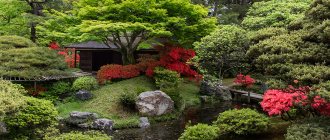If you want to make a Japanese garden at your summer cottage, you need to understand the planning principles used in oriental design. It doesn't have the usual concrete paths and doesn't look like your standard grassy barbecue area. This is a small and harmonious little world, perfectly integrated into the landscape, created specifically for a leisurely relaxation.
What is a Japanese garden?
The philosophy of oriental landscape design is not always clear to Europeans, who are accustomed to constantly remaking the natural landscape at their own discretion. The Japanese garden is a corner of the site, designed according to the ancient tradition, the origins of which were laid by the wisest Buddhist monks back in the 8th-18th centuries. This style is distinguished by elegant decorativeness. Depending on the variety, such gardens can be filled with blooming greenery or consist primarily of sand and stone elements, forming abstract open-air compositions.
Rock garden
The basis of a Japanese rock garden is, of course, stone. Stone in its original form is the main attribute of a Japanese park. The aesthetic properties of raw stone are mainly used in rock garden architecture. The Japanese rock garden is a unique structure. Its main territory is covered with sand or small pebbles, and groups of rough stones are scattered across it, so to speak. However, the chaos is only apparent. The arrangement of groups and the composition of stones in groups are subject to the rules arising from the ideological concepts of Zen Buddhism. The stones are arranged in groups of three according to the Buddhist triad. Rock gardens are functionally created for meditation, solitude from the bustle of the world and everyday problems. The design of such structures, which meets the standards of Zen Buddhism, enhances the Japanese desire for admiring nature, meditation and solitude. Here such principles as the ability to see the charm of everyday life and elegant simplicity are clearly manifested.
History of the Japanese garden
This style direction in the Land of the Rising Sun has been developing for one and a half thousand years. The story of how the traditional Japanese garden arose can be divided into the following stages:
- VI-VIII centuries
- borrowing of the Chinese tradition, which was especially evident in the design of the surroundings of the imperial capital of Nara. The main elements of the composition are mountains and water. - IX-XII centuries
- during the Heian period, the capital of Kyoto was built. A Japanese-style garden for the tea ceremony appears; many of its own highlights are used in the landscape design. - 15th century
- the invention of a simple but extremely original arrangement for a tokonoma niche (an alcove in the walls of a Japanese home). - XIX-XX centuries
- the invention of the Moribana style (a type of ikebana). The design of Japanese gardens and houses is noticeably influenced by European trends; wide floor vases are used everywhere in gardens.
Tea garden
The main structure of the tea garden - the tea house (chashitsu) - is located in the depths of the garden. Particular attention was paid to the arrangement of the tea house. This is a small room with a narrow and low (less than human height) entrance. Everyone had to bend over, thereby showing that everyone was equal. Chasitsu was reminiscent of the tiny, poor huts of oriental sages; they were extremely modest both in appearance and in interior decoration. The unpretentiousness of the situation created a higher sense of beauty, the meaning of which must be understood through a philosophical understanding of reality. The only decorations allowed were a scroll with a philosophical saying, a photograph of an old artist and a bouquet of flowers.
Japanese gardens are something unusual and unique. If I had a house with a garden, the garden would be made in Japanese style. What do you think about Japanese gardens?
Figurative symbolism of the Japanese garden
Considering the harmonious oriental landscape, Europeans sometimes do not know the meaning of many of its elements. The philosophy of the Japanese garden will be clearer if you learn to read the information encrypted by Eastern sages. Here are examples of common symbols:
- A sandy area
, carefully combed with special rakes - a surface of water with waves. - Garden paths
are the path of life. - Flat stones on the paths
- a journey without obstacles. - Small pebbles
are hills. - A group of large boulders
is a mountain range. - A gravel area surrounded by stones
is a sea bay. - Dark brown gravel
is the earth's surface. - A waterfall
is the beginning of life's journey. - Topiary bushes
are rounded mountains.
Setting up a Japanese garden
The design of a site in this style, although it sometimes looks chaotic, obeys established rules and is close to natural forms. If you want to get a spectacular Japanese garden on your summer cottage, landscape design should be arranged according to generally accepted rules. For this purpose, appropriate accessories and varieties of flora are used.
Plants for the Japanese garden
A stylish courtyard in oriental design cannot be imagined without certain shrubs and trees. Not all types of Far Eastern flora take root well in our climate, so some varieties of greenery can be replaced with alternative local specimens. It is desirable that the Japanese landscape garden be inhabited by the following plants:
- sakura;
- hawthorn (soft, Arnold, Morden, blood red);
- pine (spherical or spherical-spreading);
- thuja;
- fir;
- viburnum;
- bloodroot;
- rhododendrons;
- kalmia;
- maple;
- buckthorn;
- bamboo.
Herbs for the Japanese garden:
- miscanthus;
- dichantelium;
- Hakonechloa;
- emperor;
- mosses;
- saxifrage;
- primrose;
- swimsuits;
- hellebores;
- sedge.
Elements of a Japanese garden
In addition to vegetation, there are other special elements that give the landscaped area a stylish oriental look. In order for a Japanese garden to acquire the required appearance, it needs to be filled with iconic attributes, without which the site will look like a simple well-groomed lawn with a trimmed lawn. List of basic elements for realizing the plan:
- The bridge in the Japanese garden
is necessarily curved, symbolizing the difficult path of a person’s life. - Tsukubai
is a massive stone vessel for ablution. - Sculptures in the Japanese garden
- statues of Confucius and Buddha, sculptures of pagan deities, birds and animals. The figures are mounted on stands and pedestals and range in size from 0.3-1 m. - Pagoda
– number of tiers 3-13 (always an odd number). You can use a symbolic sculpture of a pagoda instead of a full-fledged building, in which case it should be higher than the stones, but lower than the bridge. - Bells made of glass, metal or copper
. - Bamboo fence
. - Japanese stone lanterns
- yukimi-gata, tachi-gata, oki-gata, katsuga, ikekomi-gata.
Basic elements of Japanese landscape design
The characteristic elements of this style are stones, water and plants; they are complemented harmoniously and as naturally as possible by small architectural forms.
Stones in a Japanese garden
These motionless guardians symbolize stability, strength and eternity, radiating peace and harmony. They set the structure of the garden, therefore they are a mandatory element. There are a lot of options for placement and application; this is a whole art that embodies the key point of this style. With their help, they create accents in the water, use them to build bridges, pave paths, or simply fit them into a natural composition (for this purpose, they are placed only asymmetrically).
Water in a Japanese garden
Water in Japan has a special meaning. It is a symbol of prosperity and an inexhaustible source of vital energy. It is considered the fastest of natural elements, therefore it sets the mood and rhythm for the garden and the entire house. According to Eastern beliefs, the more water, the better. Therefore, there simply cannot be too many bodies of water! When designing an area in the Japanese style, a wide variety of bodies of water are used - ponds, waterfalls, streams. The only thing that must be observed is no imitations!
Plants in a Japanese garden
They, like other elements, help create a miniature model of the universe (which, in its essence and concept, is what any Japanese garden is). Since the universe is very small, the plants used in it are also small - shrubs and low trees (chaenomeles, azaleas, quince, sakura, pine). Japanese quince, like sakura, occupies a special place in the landscape design of such a garden. They serve as both decoration and symbols. Quince represents longevity and fertility. Sakura reminds that everything comes, but life is fleeting. Only beauty is eternal.
According to Japanese tradition, all bushes and trees are given a round shape, this symbolizes the sky. Although the plants themselves emphasize the change of seasons (from cherry blossoms blooming in spring to chrysanthemums blooming in late autumn), symbolizing the transience of life and the unstoppable passage of time. To enhance the impression, contrasts are often used that clearly demonstrate these postulates: dry trees or ancient stumps are placed next to lush flowering bushes.
Almost any of the plants has very multifaceted uses. For example, in landscape design today, Japanese spirea is used to create beautiful openwork hedges, magnificent group compositions, or used as an independent decorative unit.
Small architectural forms in a Japanese garden
It is with their help that the garden turns into a small universe. All of them are made from natural materials - wood, bamboo (reed), stone, harmoniously intertwined with nature.
Even lanterns, a symbol of virtue and kindness, are made of stone in a Japanese garden. The use of many other small architectural forms is also envisaged - garden screens, light gazebos and pagodas, simple benches and, of course, bridges. They can be very different: made of bamboo and wood, light and refined, floating above the water mirror, or deliberately rough, made of stones laid on the bottom of a stream.
Japanese style rules
This type of landscape is radically different from the lush European garden compositions we are accustomed to. The Japanese garden is arranged according to traditional rules, but the owners of the site still have room for imagination. For example, even the obligatory presence of a water surface can be embodied in symbolic form by constructing alternative dry ponds and streams from calibrated or river gravel.
Features of the Japanese garden:
- Maximum natural outlines of all decorative elements without the use of strict lines. For example, if you are laying a stone path, then make it winding.
- A mandatory combination of water and rough stone.
- The coloring of vegetation and accessories is mostly restrained.
- A Japanese walking garden is created for contemplation, and not for active recreation; there is always an open area for meditation.
- The landscape should look harmonious all year round.
- Use of oriental accessories.
Hilly Garden
The hilly garden is one of the classic types of Japanese gardens. A hilly garden can be large or small, but usually has a pond at its center, or in the case of a dry landscape, a “sea” of gravel. The main feature of the hilly garden is a hill complemented by a pond and a stream. The level garden does not have the slightest potholes; it is as flat as a table. The garden uses stones, trees, stone lanterns, ponds and springs. Put together according to the architect's taste, they are unique. A well-kept landscaped garden in Japan is created by fans and professional gardeners. This garden reproduces a miniature model of the mountainous region of Japan with a small lake with an island, creatively placed stones, decorative stone lanterns, bridges and walkways.
Types of Japanese gardens
The mysterious and, for many, outlandish oriental landscape design has several varieties. A Japanese mini-garden can be made hilly, flat or rugged (reproducing mountainous terrain in miniature form). Depending on the variation, the main attributes become different elements - stones, green spaces, an oriental-style pavilion.
Types of Japanese gardens:
- Tree garden.
- Japanese garden Tsubo.
- Tea garden.
- Rock garden.
Tsubo
In Japanese, one of the meanings of this word denotes a measure of area of 3.3 m², so here we are talking about an extremely miniature composition. Creating a Japanese garden in this form has the goal of creating a tiny piece of natural landscape in a cramped urban setting. Mosses are used in decoration. Of the large plants, only one species is planted on a tiny patch, often bamboo. You can install a stylish stone lantern and lay out a path of stones in the patio.
Rock garden
In this design, the stone is not a simple building material, but a sacred element. It is not the geometric shapes of the blocks that are important, but their location. The Japanese rock garden was originally created for contemplation; it helps to concentrate and mentally evoke the necessary images. According to their shape, boulders are divided into recumbent, flat, curved, statue and vertical. The texture and color of the material plays a role; in Japan the following breeds are used:
- tuff;
- chlorite;
- basalt;
- andesite;
- granite.
The gravel in the rock garden represents the surface of the water; grooves are used to create circular circles on the surface. The free space is filled with pebbles. The design uses a heptagonal network of conventional lines, where the blocks are located at different intersection points. If at some vantage points you can contemplate all the objects of the garden, then at other points some symbolic boulders will not be visible.
Tree garden
The smaller the site for planting, the smaller the trees planted on it. Special agricultural techniques are often used to limit the growth of seedlings. Variegated representatives of the flora are not used in the landscape. Shrubs are selected in such a way that they are suitable for the desired formation. When pruned, plants are given a natural shape. A Japanese garden should be perfectly visible from the windows of the house. Decorative elements are widely used in the landscape - hedges, lanterns, bridges, ritual sculptures.
Tea garden
The purpose of a garden composition is to help a person put aside thoughts about the hectic world. As one approaches the chashitsu (tea house), located in a perfectly decorated area, one gradually prepares for the ceremony. The Japanese garden at the dacha is designed in the style of a mountain slope overgrown with vegetation. Natural elements are arranged in an order that mimics the natural environment. The tyasitsa is installed in the depths of the garden; the entrance to the room is traditionally shorter than average human height. The house is decorated modestly - with a painting in a retro style, bouquets of flowers, a scroll with hieroglyphs.
Waterfalls in Japan, their significance in the garden, where to place them and how to choose stones for a waterfall.
Waterfall on the site In Japan, waterfalls were a mandatory attribute of luxurious gardens at the palaces of the emperor and courtiers, monasteries, and estates of the city nobility. A waterfall in Japanese culture symbolizes human life, which in an instant can begin, like a waterfall at its ledge, and end just as quickly. On the other hand, it is associated with infinity, since the movement of water in it does not stop. From the Japanese garden the waterfall comes to the gardens of Europe. The attitude towards a natural waterfall here is ambivalent. On the one hand, this is a fascinating spectacle, worthy of the Gardens of Eden. On the other hand, there is a thundering stream, falling from a height and plunging travelers into horror. The garden, tamed waterfall, is completely different. This is a decorative element to delight the eye and ear. By the way, it is believed that contemplation of a waterfall activates the right hemisphere of the brain, which is responsible for artistic images and symbols (as opposed to the left, which is responsible for speech and logical thinking). Thus, the waterfall is also a source of inspiration, helping to free the mind from unnecessary words and move away from everything unnecessary and vain.
Create a beautiful view The view of falling water is exactly what a waterfall is for. Therefore, it should open beautifully from as many viewpoints as possible. It is advisable that you can admire it from the windows of the living room and kitchen. Either way, build the waterfall in a place where it can be enjoyed as much as possible. A waterfall is placed not only in the main courtyard, but also in the patio, in the winter garden, even on the balcony of a residential building. Often the waterfall is “supported” on a stone or brick fence. A waterfall beautifully complements a pond or lake. Small cascades in a stream look good.
Select an available material There is no universal waterfall solution; each site requires an individual approach. However, in order for the waterfall project to be successfully implemented, it is best to use natural materials that are common in your area or in nearby regions. This will allow the waterfall to organically fit into the surrounding landscape. And, importantly, natural materials will allow you to create a waterfall without causing damage to the environment. Artificial stone is a more inexpensive material, and at the same time no less reliable than natural one. Plus it weighs much less. Availability of materials is an important criterion for another reason. A waterfall can set the overall tone for the entire area, and you may want to place larger stones, boulders, or rockeries of the same material in other parts of the garden, so it's best to ensure that additional materials are always easy to obtain. You can use other materials to create a waterfall. For example, a monolithic casting made of polymer concrete allows you to experiment almost endlessly with the shape of the stone. Each element is individual and unique thanks to a special technology: first, a cast is taken from natural stones in the mountains, and then a polymer concrete stone is cast using this cast. Therefore, stones do not repeat, just as they do not repeat in nature. Polymer concrete is the lightest of materials: 1 m3 weighs only 60 kg (for comparison, the weight of artificial stone is 120 kg/m3, natural stone is 700 kg/m3). The advantage of stone blocks made of polymer concrete is that they are hollow, so you can hide the necessary equipment inside: a pump for a waterfall, etc. And if the size of the block is large enough, you can organize entire rooms there: a sauna, a relaxation room or a technical room. For example, the GORRA company uses this technology.
Author: Veronika Alimova Source: LANDSCAPE. design
© 2021, . All rights reserved.
DIY Japanese-style garden
Creating a harmonious landscape composition requires money and time, but the result is an ideal place for contemplation and peaceful pastime. Let's look at an example of how to plant a Japanese garden on a small summer cottage:
- A quiet rest requires the possibility of privacy, so the meditation area needs to be hidden from view by a hedge, a stylish plank or bamboo fence.
- If you have good funding, a reservoir can be realized in the form of a real pond.
- An alternative to a natural reservoir is a “dry” stream made of pebbles and sand.
- We lay walking paths in the form of winding lines passing along the periphery of the Japanese garden.
- The paths are made of stone tiles or wood.
- You can use benches and install a bridge on the territory.
- A traditional element for the eastern garden is the tsukubai bowl - a stone container 20-60 cm high for ablution.
- It is advisable to hide water hoses underground or behind plantings.
- Among the plants in the Japanese landscape, medium-sized coniferous trees and evergreen shrubs dominate.
- In harsh climates, you can plant shadberry instead of sakura; flowering bright representatives of the flora are rarely used and in limited quantities.
- We install decorative elements - lanterns, statues, pagoda, tea gazebo.
Where to order landscape design in Japanese style in St. Petersburg?
The AG GARDEN DESIGN company offers professional services for the installation of Japanese landscape design in St. Petersburg and the region.
- Our specialists know all the intricacies of creating Japanese landscape design and are able to take into account the characteristics of the site.
- At your service is a team of craftsmen with specialized skills, knowledge and extensive experience in creating Japanese design in a variety of areas.
- We approach each site individually, avoiding template solutions, but taking into account the interests of the owners.
- Regardless of the scope of work, we offer the lowest possible prices for landscape design of a site, regardless of the chosen style.
- We always do our work efficiently and quickly.
- We will be happy to transform your site into a harmonious corner of Japanese nature!











